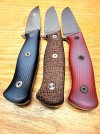I've been seeing this question pop up, about the difference between the standard Delta 3V and the harder thinner version of the Field Knife.
Our brand has always been about enhanced edge retention in rough use, addressing the shortcoming of 3V (and most other complex steels) of a tough steel with high wear resistance that goes dull due to a mushy edge.
3V is designed to be a high carbide lath martensite with stabilized retained austenite. great steel, great potential, absolutely awesome in a stamping tool and worked well as a knife. We gave up some properties that are ideal for a stamping tool such as dimensional stability and safe easy heat treat by utilizing a non-standard heat treat making it better for a knife.
There were the early tweaks, there is the Delta protocol, and some of the early field knives had a non-standard Delta protocol variation that was a combination of one of the harder tweaks and the Delta protocol. this was a multi-step heat treat process designed to put extra carbon into solution and resulted in a plate martensite with a nice crisp edge. In my goal of enhanced edge retention, which is what this has always been all about, I found that this nice crisp edge was wonderful until you start clacking it against stuff, then it was merely good not great. Ultimately, the Delta protocol has better overall edge retention than the higher hardness variation, but for some use that crisp edge lasts longer. So if you're not applying a great deal of lateral stress or impact, you like that thin hard edge. For most uses, it's tough to beat the edge retention, edge stability and wear resistance of standard Delta 3V.
To answer the question, the standard Field Knife is .020 edge thickness before sharpening, the thin variation is a little under .015. The standard hardness is 61, the higher hardness is 62. So they're actually very similar.









